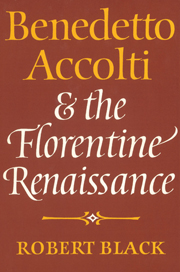Book contents
- Frontmatter
- Contents
- Dedication
- Preface
- Abbreviations
- 1 Arezzo in the early Renaissance
- 2 The Accolti family
- 3 Benedetto Accolti's early life and works
- 4 Accolti in Florence and Arezzo in the 1440s and early 1450s
- 5 Accolti's election as chancellor of Florence
- 6 The Florentine chancellorship
- 7 The Florentine chancery under Accolti
- 8 Accolti's Dialogus
- 9 Accolti's history of the first crusade and the Turkish menace
- 10 Accolti and Renaissance historiography
- Epilogue
- Appendix I Letters of Benedetto Accolti
- Appendix II Accolti's work as a palace official during his chancellorship
- Appendix III Pratica concerned with increasing Accolti's salary as chancellor
- Appendix IV Accolti and the incident of Ponzano, July–August 1463
- Select bibliography
- Index
9 - Accolti's history of the first crusade and the Turkish menace
Published online by Cambridge University Press: 12 October 2009
- Frontmatter
- Contents
- Dedication
- Preface
- Abbreviations
- 1 Arezzo in the early Renaissance
- 2 The Accolti family
- 3 Benedetto Accolti's early life and works
- 4 Accolti in Florence and Arezzo in the 1440s and early 1450s
- 5 Accolti's election as chancellor of Florence
- 6 The Florentine chancellorship
- 7 The Florentine chancery under Accolti
- 8 Accolti's Dialogus
- 9 Accolti's history of the first crusade and the Turkish menace
- 10 Accolti and Renaissance historiography
- Epilogue
- Appendix I Letters of Benedetto Accolti
- Appendix II Accolti's work as a palace official during his chancellorship
- Appendix III Pratica concerned with increasing Accolti's salary as chancellor
- Appendix IV Accolti and the incident of Ponzano, July–August 1463
- Select bibliography
- Index
Summary
Benedetto Accolti's second composition as chancellor and his longest work was De bello a christianis contra barbaros gesto pro Christi sepulcro et Iudea recuperandis libri IV, a history of the first crusade. He begins the first book with an account of the rise of Islam and the loss to Christianity of the holy lands, and goes on to recount Peter the Hermit's and Pope Urban II's efforts to launch a crusade, including a version of Urban's famous oration at Clermont in 1095. He then describes the abortive expeditions of Peter the Hermit, Walter the Penniless and Gottschalk, and ends the first book with Bohemond, the Norman prince of Taranto, taking the cross and delivering a long oration to persuade his compatriots to follow his lead. In the second book, after describing the journey to the East of the main crusading armies under Bohemond and Godfrey of Bouillon, Accolti gives an account of the siege and capture of Nicea, whose Moslem governor is portrayed delivering an impassioned oration to rouse his subjects to withstand the Christian onslaught. There then follows a long digression on Baldwin of Bouillon's success in winning a principality in Armenia, and an account of the journey of the main crusading force to Antioch; the second book concludes with an oration by Godfrey to the crusading army before the walls of Antioch. The main event of the third book is the siege and capture of Antioch by the crusaders, after which Accolti describes the unsuccessful attempt by a large Muslim force to recapture the city.
- Type
- Chapter
- Information
- Benedetto Accolti and the Florentine Renaissance , pp. 224 - 285Publisher: Cambridge University PressPrint publication year: 1985



